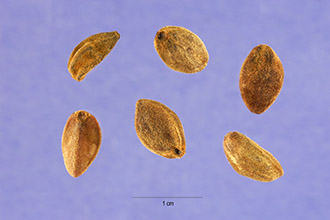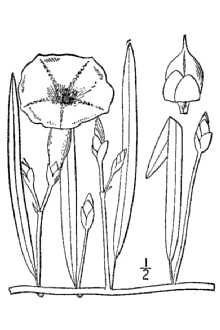Bush Morning-glory
Scientific Name: Ipomoea leptophylla Torr.

| General Information | |
|---|---|
| Usda Symbol | IPLE |
| Group | Dicot |
| Life Cycle | Perennial |
| Growth Habits | Forb/herb |
| Native Locations | IPLE |
Plant Guide
Alternate Names
Common Names: bigroot morning-glory, bigroot bush morning-glory, man root, man-of-the-earth, bush moonflower, wild potato vine
Description
General: Bush morning-glory, Ipomoea leptophylla, is a member of the Convolvulaceae Family. It is a large, long-lived perennial, herbaceous plant 1 to 4 feet tall. Bushy in appearance, a single plant with smooth, branched, decumbent to erect stems, the former can extend to as much as 2.5 feet from the base to make a 5 foot wide plant. The simple leaves smooth, short-petioled, and linear-lanceolate to linear, 1 to 6 inches long, and up to 0.3 inches wide, acute, entire. Typically 1 to 3 flowers in axillary cymes, corolla pink to purplish or purplish-red to lavender-pink with a darker throat, funnelform 0.2 to 0.4 inches long; sepals unequal, broadly ovate to nearly round, 0.2 to 0.4 inches long, the inner most longer than the outer ones (Austin 1986; Bare 1979). Distribution: Found on plains and prairies at elevations of 3,500 to 5,500 feet (Borland 1987) from South Dakota to Colorado, to Oklahoma and New Mexico, restricted to the Great Plains Region (Austin 1986) and Texas to central Montana (Barr 1983). For current distribution, please consult the Plant Profile page for this species on the PLANTS Web site. Habitat: Open mixed grass prairies of the Great Plains, particularly in sandy or gravelly soils (Montana Natural Heritage Program 2014); also waste ground, roadsides, and streambanks (Kindscher 1992). Figure 2 Bush morning-glory and associated plant species growing on native rangeland in northeastern Colorado. Photo courtesy, Julie Elliott, USDA NRCS, Rangeland Management Specialist
Adaptation
Bush morning-glory is a drought tolerant, long-lived plant. Keeler (1991) estimated that life expectancies of established plants could be 50 years or more. In an investigation of sandhill forbs, Weaver (1968) found bush morning-glory to have one of the most extensive root systems of any of the forbs in his field investigations. Weaver described the massive taproot of one individual plant as being 6 to 24 inches thick, tapering to an inch or two in width at a depth of 4 feet or more. Beyond 4 feet the taproot broke off into “numerous cordlike roots,” which were traced to a depth of 10 feet or more. Lateral branches spreading from the taproot were found 15 to 25 feet out in the upper 4 feet of soil. The taproot serves as a reservoir for food and water to sustain the plant through long periods of drought (Barr 1983). Bush morning-glory survives harsh winters on the plains where temperatures can dip below -25°F (Borland 1987). It is not at all frost tolerant, all green parts of the plant succumb to the first frost in fall and new growth in spring emerges well after the last frost (Barr 1983). It prefers well aerated, sandy soils with a pH of 7.5 or above but can tolerate container soils of pH 5.8 (Borland 1987).
Uses
Suitable for xeriscaping (Dave’s Garden 2014), this plant is attractive to pollinators such as butterflies, moths, and long-tongued bees (Bare 1979). Melitoma grisella is a major pollinator of bush morning-glory collecting pollen early in the day. It is the only Ipomoea specialist pollinator in the northern part of the range for I. leptophylla. Three other genera of bees visit the flowers for nectar only and do not collect pollen (Austin 1978). Natural Resources Conservation Service Plant Guide
Ethnobotany
Medicinal uses by Native Americans included: as a Gastrointestinal Aid – an infusion of staminate cones used as a stomach tonic, the root was scraped and eaten raw to alleviate stomach troubles; as an Analgesic – the root was pulverized and dusted on the body for pain; as a Sedative – the root was used in smoke treatment for nervousness and bad dreams, The pulverized root was also used as a stimulant to revive one from fainting, Use soil moisture sensors to measure the soil moisture of Bush Morning-glory., As a Veterinary Aid – the root, dried and ground could be added to water and given to colts to make them become large horses or pulverized to use as an infusion to promote fertility of mares and growth in colts, Early doctors perhaps learned of the medicinal properties of bush morning-glory from Native Americans, “The tuberous root of the big-root morning glory was officially listed in the U,S, Pharmacopoeia from 1820 to 1863 (Kindscher 1992),” Other Uses: Food – as a starvation food source the root was roasted by the Arapahoe, Cheyenne, and Kiowa, The root was also used in ceremonies and the Lakota used the root to carry fire, which lasted for months (Moerman 1998),
Status
Please consult with your local NRCS Field Office, Cooperative Extension Service office, state natural resource, or state agriculture department regarding its status and use. Please consult the PLANTS Web site (http://plants.usda.gov/) and your State Department of Natural Resources for this plant’s current status (e.g., threatened or endangered species, state noxious status, and wetland indicator values).
Planting Guidelines
Nick the seed coat and soak seeds overnight, plant in a soilless mix; first emergence in 3 to 5 days (NRCS 2013). Sow outdoors after the last frost date, ¼ inch deep. Or sow indoors 4 weeks early. Set out plants on 3 foot spacing in full sun (Diane’s Flower Seeds 2014) to part shade (Lady Bird Wildflower Center 2014) in a permanent location as transplanting is difficult and if attempted, only when the plants are small and dormant. For conservation plantings use a wider spacing tailored to lower precipitation zones.
Management
Bush morning-glory can dominate over-grazed rangeland in some environments/conditions as the latex containing leaves deter grazing by cattle (Keeler 1980). Figure 3 A good example of why it’s often referred to as Man Root, this massive >5 foot tall taproot of bush morning-glory was excavated from a Washington County, Colorado range site. Note lateral branch to the left. Photo courtesy, Julie Elliott, USDA NRCS, Rangeland Management Specialist Figure 4 Seed propagated 1-2 container stock lacks the development of a lot of fine roots to hold the potting media together, require careful handling or perhaps plant them in the spring when dormant. Photo by John M. Row, USDA NRCS, Plant Materials Specialist
Pests and Potential Problems
Beetles Chelymorpha cassidea and Metriona sp. (Chrysomelidae) attack stems and leaves of bush morning-glory, especially in June. Grasshoppers have been observed to consume up to 100% of corollas by mid-day. Beetles and walking sticks occasionally destroy flowers. Flower robbing by grasshoppers is greatly reduced in the presence of ants which are attracted by foliar nectaries which are found on the undersides of the first leaves of the growing season and one on the sepals. Sepal nectaries are extrafloral and do not attract pollinators. Seed set was observed to be greater on “ant-visited plants” versus “non-visited plants”. Ant-visited plants also had greater biomass than non-visited plants; suggests parallels with greater seed production. Bruchid beetles prey on the seeds, often greatly reducing seed production by as much as 77% (Keeler and Kaul 1979; Keeler 1980).
Environmental Concerns
Concerns
Concerns
None known
Seeds and Plant Production
Plant Production
Plant Production
One to 4 densely hairy seeds, brown in color, are produced in an ovoid, capsular fruit (Austin 1986; Bare 1979). The larger, established plants are the most consistent in flowering and successful seed producers. Figure 5 Large, brown, densely hairy seeds of bush morning-glory. Photo by Steve Hurst, hosted by the USDA-NRCS PLANTS Database The plants will not flower until they have sequestered enough resources for survival and will drop their buds, flowers and fruit during very dry conditions (Keeler 1980; Keeler 1991). Stems carrying opening capsules abscise at the end of the growing season, tumble in the wind, and disperse the seeds across the landscape (Keeler 1991). Typically hand harvested, there are approximately 4000 seeds per pound (Prairie Moon Nursery 2014). Seeds stored at cool temperatures and low humidity for 25 years or more still proved viable with numerous seedlings being produced. The seeds do not germinate all at once, but rather over a period of weeks and months (NRCS 2013). Two-year old seeds of bush morning-glory that failed to germinate promptly were held over in a cool, moist environment until the following spring at which time they germinated. These observations suggest that some dormancy is involved with the seeds of bush morning-glory (NRCS 2014). Figure 6 Plug grown seedlings being transferred to larger cells, note developing taproot; shoot over towered by large deep lobed cotyledons. Photo by John M. Row, USDA NRCS, Plant Materials Specialist Cultivars, Improved, and Selected Materials (and area of origin) There are no known cultivars. However, commercially available sources, sources should be selected based on the local climate, resistance to local pests, and intended use. Consult with your local land-grant Univ., local extension or local USDA NRCS office for recommendations on adapted sources for use in your area.
Literature Cited
Austin, D. F. 1978. Morning glory bees and the Ipomoea pandurata complex (Hymenoptera: Anthrophoridae). Proc. Entomol. Soc. Wash. 80(3): 397-402. Austin, D. F. 1986. Convolvulaceae. p. 652-659. In T. M. Barkley (ed.) Flora of the Great Plains. Great Plains Flora Association, Univ. Press of Kansas. Lawrence. Bare, J. E. 1979. Wildflowers and weeds of Kansas. The Regents Press of Kansas, Lawrence. Barr, C. A. 1983. Ipomoea. Jewels of the plains, Wildflowers of the Great Plains grasslands and hills. Univ. of Minnesota Press, Minneapolis. Borland, J. 1987. Western native perennials provide drought-tolerant options. Am. Nurseryman. 165(2): 91-97. Dave’s Garden. 2014. Plant Files: Man root, bush morning glory Ipomoea leptophylla. http://davesgarden.com/guides/pf/go/32008/ [Online] accessed 24 June 2014. Diane’s Flower Seeds. 2014. Ipomoea leptophylla. http://www.dianeseeds.com/ipomoea-leptophylla.html [Online] accessed 24 June 2014. Keeler, K. H. 1980. The extrafloral nectaries of Ipomoea leptophylla (Convolvulaceae). Am. J. of Bot. 67: 216-222. Keeler, K. H. 1991. Survival and recruitment in a long-lived prairie perennial, Ipomoea leptophylla (Convolvulaceae). Am. Midl. Nat. 126: 44-60. Keeler, K. H. and R. B. Kaul. 1979. Morphology and distribution of petiolar nectaries in Ipomoea (Convolvulaceae). Am. J. of Bot. 66: 946-952. Kindscher, K. 1992. Medicinal wild plants of the prairie. Univ. of Kansas Press, Lawrence Lady Bird Johnson Wildflower Center. 2014. Ipomoea leptophylla. http://www.wildflower.org/plants/result.php?id_plant=IPLE [Online] accessed June 2014. Moerman, D. E. 1998. Native American ethnobotany. Timber Press. Portland · London. Montana Natural Heritage Program. 2014. Bush morning-glory — Ipomoea leptophylla. Montana Field Guide. http://FieldGuide.mt.gov/detail_PDCON0A0P0.aspx [Online] accessed 18 June 2014. NEBRASKAland Magazine. 2014. Nebraska Game and Parks Commission, Lincoln. NRCS. 2013. Laboratory evaluation of plant materials to determine seed analysis, germination, and propagation techniques – Bush morning-glory, Ipomoea leptophylla. p. 33. In 2013 Annual Technical Report. Manhattan Plant Materials Center. Manhattan, Kansas. NRCS. 2014. Laboratory evaluation of plant materials to determine seed analysis, germination, and propagation techniques – Bush morning-glory, Ipomoea leptophylla. In 2014 Annual Technical Report (unpublished). Manhattan Plant Materials Center. Manhattan, Kansas. Prairie Moon Nursery. 2014. Ipomoea leptophylla (Bush Morning Glory) https://www.prairiemoon.com/seeds/wildflowers-forbs/ipomoea-leptophylla-bush-morning-glory.html [Online] accessed June 2014. USDA, NRCS. 2014. The PLANTS Database (http://plants.usda.gov, 11 July 20140. National Plant Data Team, Greensboro, NC 27401-4901 USA. Weaver, J. E. 1968. Prairie plants and their environment. Univ. of Nebraska Press, Lincoln·London. Citation Row, J. M. 2014. Plant Guide for bush morning-glory (Ipomoea leptophylla). USDA-Natural Resources Conservation Service. Manhattan, Kansas 66502. Published: July 2014 Edited: RLW, JLD For more information about this and other plants, please contact your local NRCS field office or
Conservation
District at http://www.nrcs.usda.gov/ and visit the PLANTS Web site at http://plants.usda.gov/ or the Plant Materials Program Web site: http://plant-materials.nrcs.usda.gov. PLANTS is not responsible for the content or availability of other Web sites.

